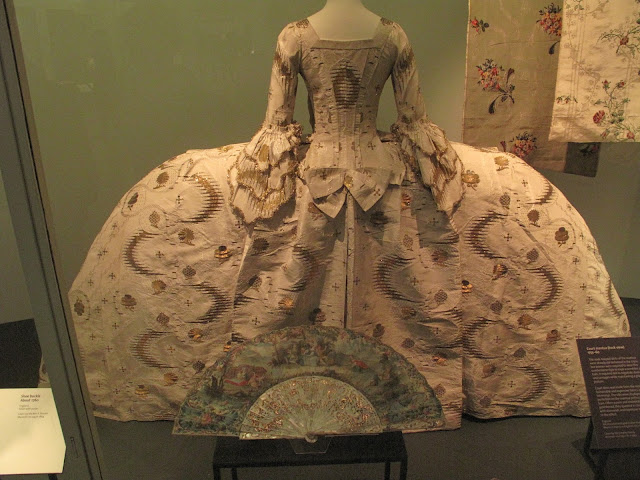 |
| Mid-18th century "Court Dress" |
Here are more pictures of my favorite pieces in the fashion gallery of the Victoria and Albert Museum. (I apologize in advance for all the reflections in the glass - but unfortunately it was impossible to avoid them entirely.)
To be around actual clothing worn by actual people from the past gives me the most incredible feeling. It is the past preserved - a little piece of history that as I stand before it opens up an entire world. Knowing it belonged to a person who was just as human as I am, who wore this piece of clothing as they were living their life, interacting with their family and friends, walking on the streets where they lived and drinking tea in their homes drops me into their life for a moment. To me this is what is so special about a mannequin in a museum with some clothes on it.
Now I am done with my rhapsodizing and philosophizing: on to the clothes! The photo above was oldest piece, dating from the mid-18th century. It is "court dress," which, as you might guess, is what was worn in the royal court. It was even more than the popular style, it was
required. I don't know what they did if you failed to meet the requirements, but I suppose they simply didn't let you in. It isn't very practical, but you must admit that it makes a statement!
The gallery was arranged chronologically, so the next piece is from a bit later in the 18th century. This blue damask gown has lots of that gathered trim that I like so well. There is something so distinctly Georgian about it, too.
 |
| A Georgian gown, circa 1760s. |
Ah, the robe a la polonnaise! Possibly my favorite historic fashion. This was the fashion of Jane Austen's parents, George and Cassandra. It has cleaner lines and a more classic shape than earlier Georgian styles, adding to its elegance and practicality, and giving it a more timeless style than the oversized skirts and plethora of ruffles and trims that preceded it.
 |
| Robe a la Polonnaise, circa the 1770s and 1780s. |
 |
| The typical Polonnaise skirt that can be looped up, as it is here, or left to hang straight. |
Even the underpinnings are a work of art in the 18th century! I knew this, as I have attempted my own, but I was impressed by just how tiny everything was. There were dozens of boning channels, and the armhole was lined with what looked like leather, which I think is rather a marvelous idea, since that part of the garment would have a lot of wear and tear.
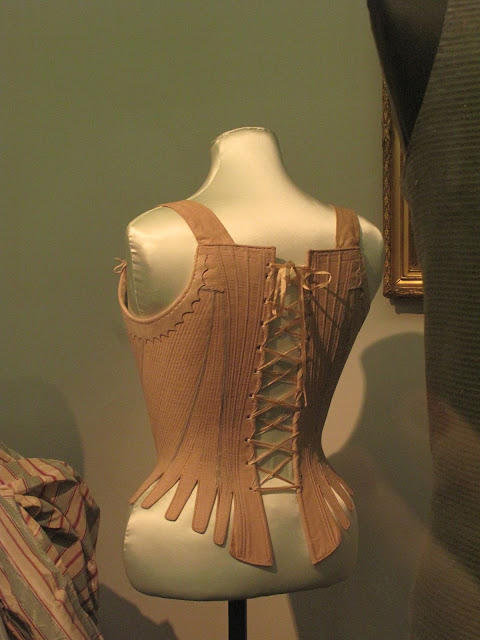 |
| The work of art that is a set of 18th century stays. |
|
|
|
|
|
Here is a most familiar style. If you have seen 'Pride and Prejudice,' you know when we are: the unique and fabulous Regency! Practical, elegant and with a most distinct style, the dresses of the Regency were a result of a sort of revolution in fashion, discarding the more restrictive shapes of the Georgians in favor of more natural (think: Rousseau) shapes. I think women, once they got over the shock, must have rejoiced at the freedom of movement they could achieve in this new fashion. :)
The first dress in the gallery is a day dress of the middle Regency, with a straighter skirt than those of the earlier Regency, and a practical print. Jane Austen may have worn a dress like this when she lived at Chawton Cottage in 1810.
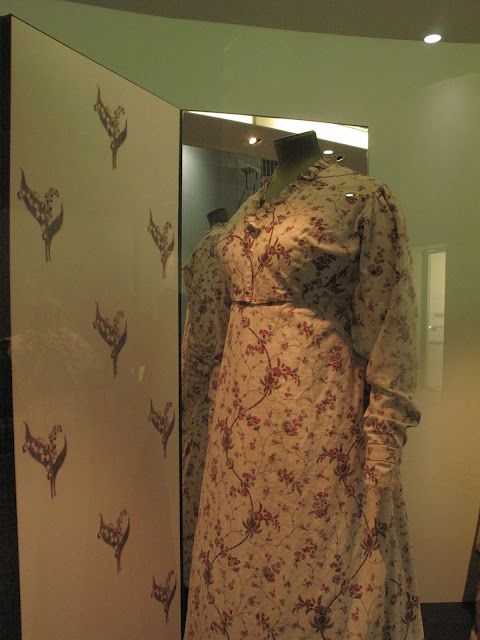 |
| A middle Regency printed day dress. |
 |
| More of the day dress. |
This is an early Regency style, with a closer resemblance to the portrait dress of the 1790s in its fuller skirt. It was difficult to see or get a shot of the front, but I believe it is a crossover gown made in a simple white muslin.
 |
| An early Regency crossover gown. |
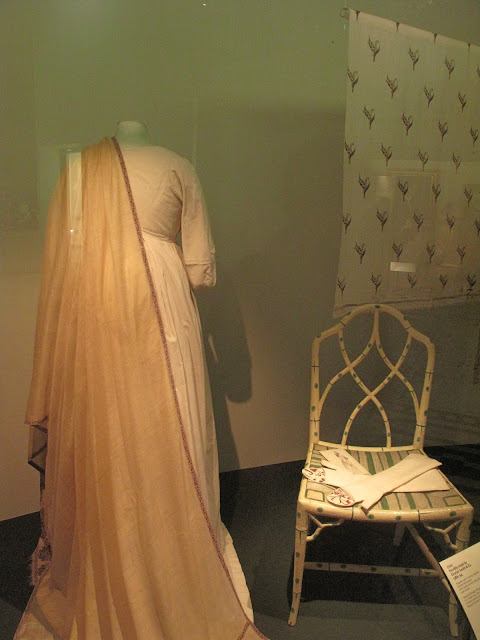 |
| This early Regency gown illustrates the long classical silhouette of the era. |
|
|
This gown illustrates the transition from the Regency to the Romantic style, with the waist being lower and the sleeves larger. It was a spectacular piece! The detail was mesmerizing. I could tell this would have belonged to a very wealthy young lady because of the sheer amount of expensive trim. :) All of that intricate lace and gold work all over the entire dress would have cost a fortune.
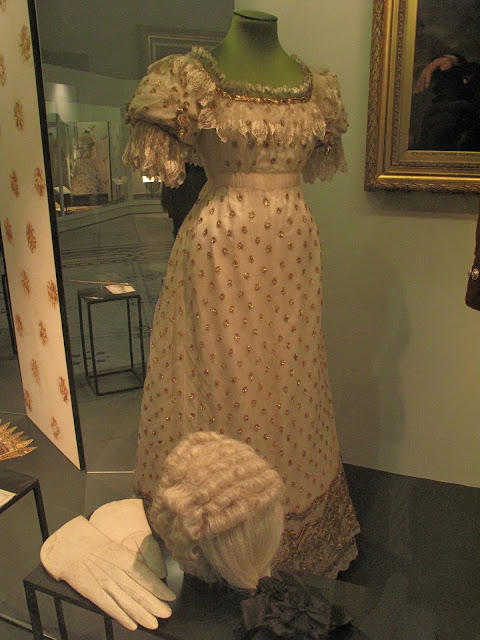 |
| A dress circa 1820 transitioning between the Regency and Romantic styles. |
 |
| Oh, the detail! |
A walking dress from the same period. Another point of transition that can be seen in this dress is in the line of the skirt, especially in the hemline. It doesn't just hang from the waistline, there are corded petticoats and techniques used to stiffen the hem so that it has a more unchangeable A-line shape, hanging rather like a bell when the person wearing it is walking.
 |
| A walking dress, circa 1820. |
And now we come to the fully-fledged Romantic fashions! The sleeves make this unmistakable. The style went back to the natural waist, accentuated by more petticoats (and the big sleeves).
 |
| Dresses from the Romantic era, circa 1830s. |
A more perfect example of Romantic underpinnings may be impossible to find in this day and age. Upon first seeing this I may have been more excited than I would now care to admit... But it reveals all of the secrets to the silhouette of the Romantic era! The sleeve pads, the stays, the corded petticoat - now it all makes sense. Especially the sleeve pads. It seems almost ingeniously simple, now, but for a long time I wondered how they successfully kept those enormous sleeves puffed.
 |
| Secrets revealed: the underpinnings of Romantic era fashion. |
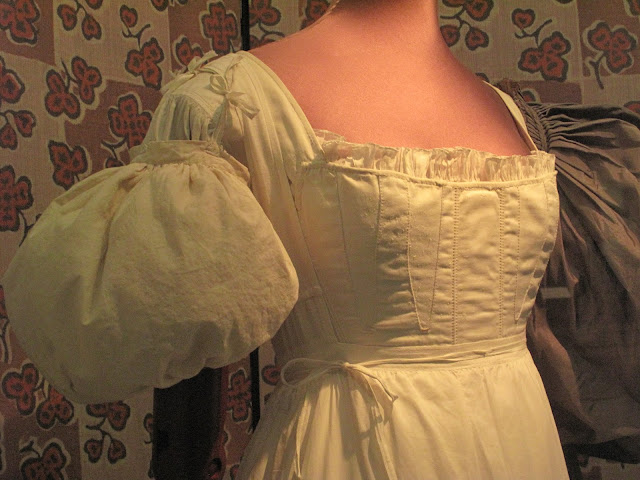 |
| I had to get a close-up. |
Next in the gallery was the fully-fledged Victorian era with its tiny waists and big skirts. I am by no means an expert in Victorian fashion, so I cannot regale you all with its style details or particularly distinctive elements. I have only seen some period dramas that had these exact same styles in them. For example: this next dress looks almost identical to a dress Margaret Hale wears in the BBC adaptation of 'North & South' (except hers is a print and no skirt ruffles). I have always thought it was a lovely style, so to see an original dress in that same style and in person was quite exciting. :) It was a wedding dress and made out of a fine, thin muslin.
 |
| An early mid-Victorian gown, circa 1850. |
This one was rather eye-catching... It is quite a fabulous color! This is mid-Victorian, worn in 1869-70, and style has moved on to the hoop skirt. A person can tell that the next style will be the bustle by looking at how the skirt is made. I personally think this style is a bit more elegant than a bustle, but we won't get into that. :) I think hoop skirts would be rather awkward to wear, too, actually. But those were the styles!
 |
| Mid-Victorian gown, circa 1870. |
If you have seen 'Lark Rise to Candleford' you will understand when I say that this ensemble reminds me so much of Dorcas Lane. It must be from exactly the same era, the late Victorian - probably the early 1890s.
 |
| Historic fashion: "It's my one weakness." |
Here is an ensemble from the elegant and opulent Edwardian era. This skirt and blouse were worn in 1910-12, just before the Titanic sank and the drama of 'Downton Abbey' begins.
 |
| Edwardian ensemble, circa 1910-12 |
I thought this dress and this hat were two of the most elegant pieces in the gallery. That gown has such exquisite work on the thinnest of thin white muslins, draping so gracefully. This is another piece in the Edwardian section of the gallery.
I think that hat belongs at the Ascot races in 'My Fair Lady.' :)
 |
| Edwardian evening dress and hat. |
The roaring 20s! I don't need to point out the distinctive elements of this style or how it changed from the decade before. The biggest change may be the lack of material below the hemline... It reminds me of something Lady Edith Crawley might wear. She does seem to favor green and coral shades.
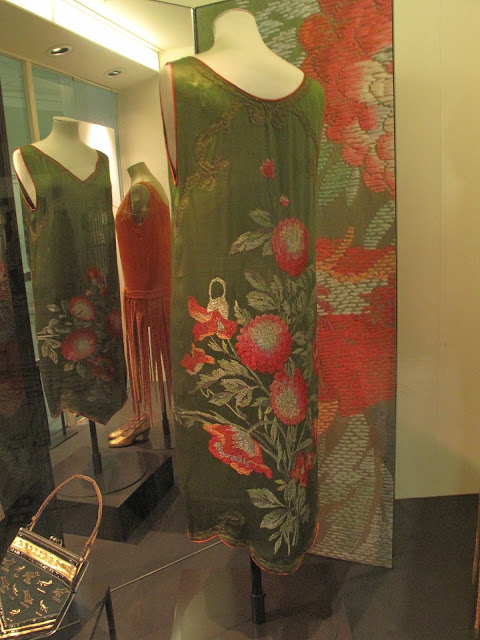 |
| A dress of the roaring 1920s. |
Now we're into the 1940s and the somewhat more conservative wartime styles with straighter skirts and squarer shoulders.
 |
| Fashion during WWII |
With the arrival of the 1950s came a return to glamor in the every day fashions. That tweedy ensemble is most tempting...
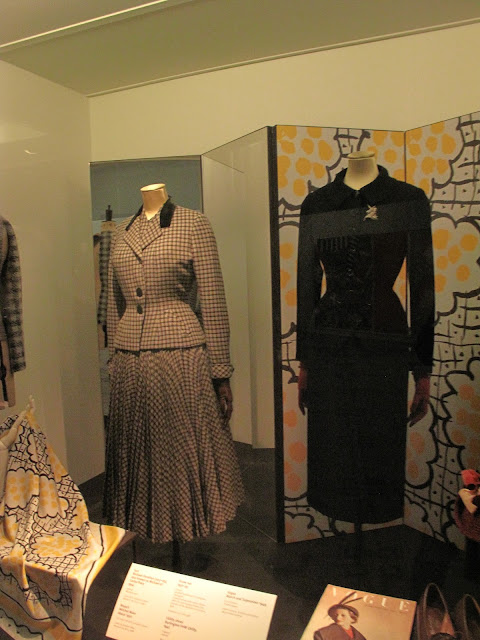 |
| Glamorous 1950s fashions. |
We have now reached the end of my photos from the gallery, and I hope that getting to look at the fashions of the past has inspired you to go to London to see it or sew a new historical costume or just do something exciting! (Watching a period drama wouldn't be a bad idea...) Clothing can teach us so much about the past and the people who lived through it, and I am indeed grateful to people who, like the V&A Museum, preserve things like this and put them out for all the world to see.
© 2015 Anna Morton

























No comments:
Post a Comment